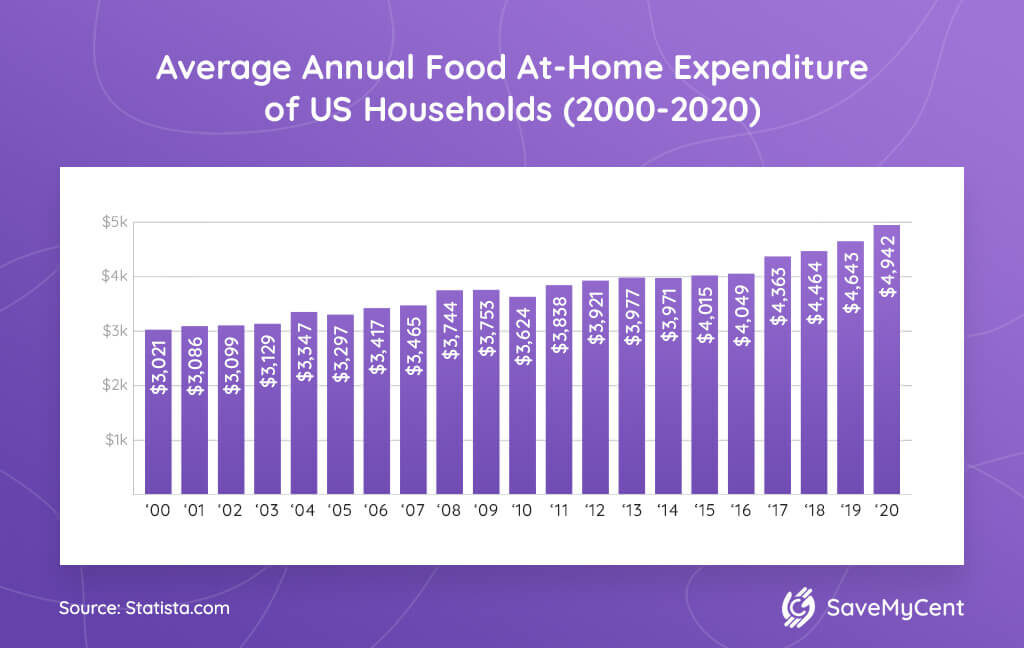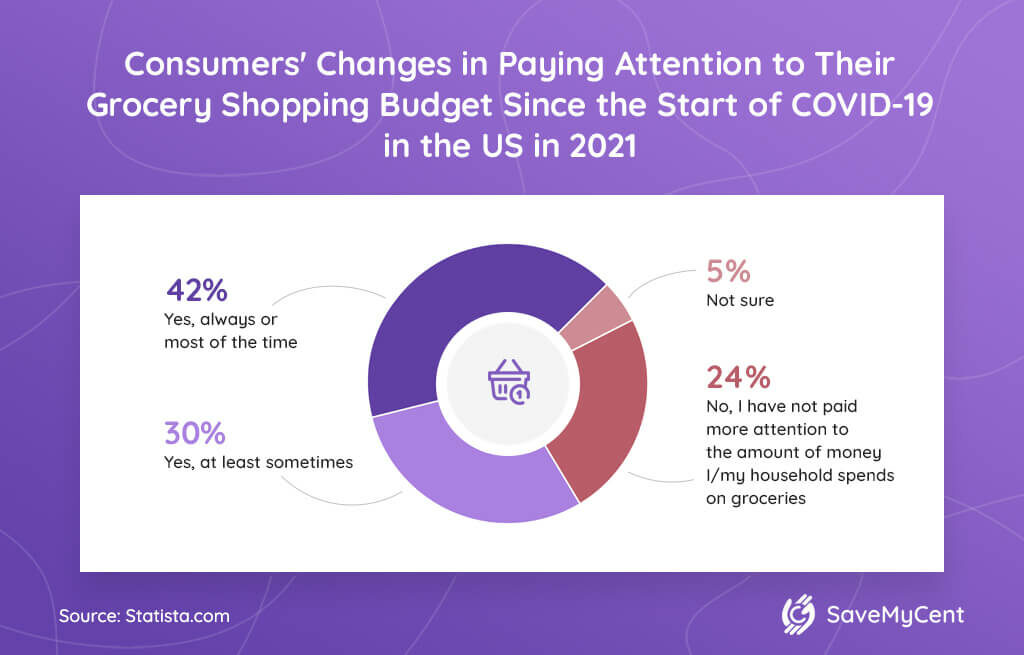The question about the average cost of groceries per month and how much your typical grocery bill should be are not as simple as they might seem. This data depends on so many factors, including your age, gender, the state where you’re living, and whether you’re buying regular or organic products.
Luckily, we’ve collected all the vital info on this topic, and we’re ready to share the wisdom. In addition, we’ll give you some stats on general food spending, college food costs, and typical spending habits in the United States.
Average Cost of Groceries Per Month (Editor’s Picks):
- In 2020, the average US household food expenditure amounted to $609.7 per month.
- The average US consumer spent about 8.6% of their disposable income on food in 2020.
- Hawaii, Maine, and Vermont are the states with the highest monthly grocery cost per person.
- Utah, Ohio, Indiana, and Alabama are among the states with the lowest average monthly cost of groceries.
- In 2020, American households spent an average of $411.83 on at-home meals per month.
- The highest-earning households spent 7% of their income on food in 2020.
- The average college student spends $260 a month on groceries.
- About 23% of surveyed Americans said that COVID-19 had a major influence on their grocery shopping habits.
How Much Do People Spend on Food per Month?
1. In 2020, the average US household food expenditure amounted to $609.7 per month.
(Statista)
This shows a decline from the previous year when American households spent a monthly average of $680.75 on meals. Additionally, the average monthly food spending in 2018 also surpassed the 2020 figure, with American households having monthly spending of $660.25 that year.
2. US households spent a monthly average of $411.83 on at-home meals in 2020.
(Statista)
Out of the $7,316 spent on food that year, nearly $4,942 was spent on at-home meals. In 2019, the yearly amount sat at $4,643, while in 2018, at-home meal spending reached $4,464. Thus, while the average cost of food per month in the US has decreased, the spending on at-home meals has increased. However, this could be attributed to the COVID-19 pandemic when the lockdowns inspired people to refine their cooking skills.

3. The average US consumer spent about 8.6% of their disposable income on food in 2020.
(US Department of Agriculture)
Throughout the years, Americans have been spending more money on food at home than at restaurants. Still, the difference wasn’t as significant as it was in 2020. Most experts believe that the COVID-19 pandemic has influenced food spending in the last couple of years.
4. The share of disposable income spent on food decreased by 10.1% from 2019.
(US Department of Agriculture)
The monthly food budget for Americans keeps getting lower. As a matter of fact, the USDA found that in 2020, the share of disposable income spent on food has decreased by 10.1% from 2019, when the total spending on food comprised 9.6% of disposable income. Aside from the changes brought about by the pandemic, one of the reasons for this decline was a large annual increase in disposable income since 2000.
5. In 2020, US households spent $89.58 per month on meat, fish, eggs, and poultry on average.
(US Bureau of Labor Statistics)
Out of the total expenditure for at-home meals, Americans spent the most on meat, fish, eggs, and poultry. Fruits and vegetables are also popular choices. The average food expenses per month for this category is $81.42 per household. Additionally, US households spent a monthly average of $53.33 on cereal and baked goods and $39.50 on dairy products that year.
6. Households earning around $200,000 spend $1,172 a year on food.
(Statista)
Logically, households with a higher income spend more on food. Moreover, people who earn from $150,000 to $199,000 spend about $11,000. Households with earnings from $100,000 to $149,000 typically allocate $9,900 a year, while families in the $70,000 to $99,000 group spend $7,500. The cost of food per month for American households with incomes lower than $15,000 is around $358.
7. Households with the highest earnings spent 7% of their income on food in 2020.
(US Department of Agriculture)
This resulted in a total average spending of $12,245 on food. While the differences in spending are significant between different income brackets, it’s worth noting that the amount spent by the highest-earning households represents only a smaller portion of what they earn. On the other hand, families with the lowest income spent 27% of their earnings on food.
Average Cost of Groceries by State
8. Hawaii, Maine, and Vermont have the highest monthly grocery cost per person.
(Business Insider)
Residents of these states spend more than $4,000 a year on groceries, which translates to over $333 per month. In addition, people from Massachusetts and Alaska usually pay anywhere from $300 to $330 per month for groceries.
9. In Colorado, Connecticut, Oregon, and Idaho, people spend anywhere from $260 to $300 a month on groceries.
(Business Insider)
Similar grocery spending was marked in Maryland, the District of Columbia, Delaware, New Jersey, and New Hampshire. Furthermore, residents of Montana, Wyoming, and Washington have similar grocery bills. This is equivalent to $3,201 and $3,600 a year.
10. The average groceries cost per month in Florida, Texas, Virginia, and Georgia goes from $230 to $260.
(Business Insider)
In addition, residents of Iowa, California, Kansas, Kentucky, Minnesota, and Nebraska typically spend this amount grocery shopping. Other states with residents of similar grocery bills are New York, Michigan, Nevada, North Carolina, Rhode Island, South Dakota, North Dakota, West Virginia, Wisconsin, and Tennessee. This translates to a yearly grocery spending of $2,801 to $3,200.
11. Utah, Ohio, Indiana, and Alabama are some of the states with the lowest average grocery bill.
(Business Insider)
The average grocery spending in these states ranges from $200 to $230 per month. Other states with similar grocery bills include Oklahoma, Pennsylvania, South Carolina, Illinois, Arkansas, Louisiana, Arizona, Mississippi, Missouri, and New Mexico. This means the yearly average ranges from $2,400 to $2,800.
Grocery Cost per Month By Age and Gender
12. Single males between the ages of 19 and 50 spend $392.70 at most on food per month.
(Yahoo Finance)
Males in this age group spend more than women, spending $392.70 at most on groceries per month. Even the thrifty males in this age group still spend an average of $197.70 per month on groceries.
Further research has shown that men in America generally have a higher average cost of food per month than women—groceries included. Data shows that a single female in the same age group spends a maximum of $348.80 on food per month.
13. The moderate food budget for an American boy between 14 to 18 years old is $298 per month.
(US News)
If you’re one of the thrifty ones, you’re likely going to spend $162.40 per month to feed a teenage boy of this age. On the other hand, a more “liberal” budget will sit at $344.40 per month. Moreover, if you have a teenage girl of this age and a moderate budget, you’re likely going to need $237.60 on food (approximately $60 less than a month for a teenage boy).
Average Cost of Food Per Month on Organic Food
14. Private-label organic food is 14.7% more expensive than regular food.
(Axios)
Organic food generally costs more money than its regular counterparts; however, the gap is starting to shrink in recent years. For example, organic apples used to cost $0.43 more; now, it’s only $0.33 more. The average food cost per month for organic items doesn’t overly exceed that for regular items. As more big-box grocery stores, such as Walmart, are adding organic options on their shelves, organic food is becoming more accessible.
15. Over the past year, the cost of organic food has increased by 2% to 4%.
(Axios)
On the other hand, regular food items saw a price increase of 11%. Analysts state that the minimal inflation seen in organic food prices is probably due to retailers being careful not to price organic items out of the market.
How Much Do College Students Spend on Food?
16. The average college student spends $260 a month on groceries.
(Education Data Initiative)
The actual amount college students spend on food depends on various factors, such as their spending habits and the state they’re located in. Thrifty college students spend a monthly average of $187 on groceries. On the other hand, college students can also spend as much as $317 per month.
17. College students in Hawaii spend the highest average amount on groceries—$461 per month.
(Education Data Initiative)
According to grocery prices by state, Hawaii has the highest cost of groceries in the US—mainly because most of the items have to be imported from the mainland. That said, it doesn’t come as a surprise that college students in the state have the highest average amount spent on groceries. Students spend over $300 a month in other states, including Alaska, New York, Vermont, and West Virginia.
18. New Hampshire college students spend the least average amount on groceries—$87 per month.
(Education Data Initiative)
New Hampshire is by far the cheapest state for student grocery shopping. Other states with a lower average cost of groceries per month for college students are Kansas, Idaho, Utah, Arkansas, and South Dakota. College students spend less than $200 per month on groceries in these states.
19. College students on a plant-based diet save $60 per month on groceries.
(Education Data Initiative)
Recent studies show that plant-based diets can be cheaper than meat-based diets. A vegetarian diet can save college students $2 daily. Additionally, students on a vegan diet spend an average of $200 on groceries per month.
Grocery Shopping Habits
20. Frequent grocery shoppers have an average weekly grocery bill of $59.
(Statista)
Many things can influence grocery costs; frequency is one of them. The more frequent your visits are to the supermarket, the higher your average spending will be. For instance, monthly shoppers spend an average of $35 per week on groceries. On the contrary, occasional grocery shoppers said their average cost of groceries per week only reaches $15.
21. About 23% of people in the US said that COVID-19 had a significant influence on their grocery shopping.
(Statista)
With persistent lockdowns, supplies running out, and everyone scrambling to look for basic food staples, the COVID-19 pandemic really changed the grocery shopping behavior of many consumers. Around 21% of women and 25% of male respondents in a survey claimed that their grocery shopping habits changed because of the lockdowns.
22. An estimated 31% of Gen Z and Millenial shoppers in the US say that their grocery shopping habits changed due to the COVID-19 pandemic.
(Statista)
When it comes to groceries, the monthly cost is not the only thing that changed; shopping habits changed as well. Aside from 31% of individuals between the ages of 18 and 39, 18% of those aged 40 to 55 buy their groceries differently now, and about 20% of those in the 56 to 74 age group can relate.
23. 42% of Americans said that they always or most of the time paid more attention to the amount of money they spend on groceries since the COVID-19 pandemic started.
(Statista)
Aside from changing people’s grocery shopping habits, the pandemic also made people more aware of their average grocery bill. While 42% of surveyed Americans stated that they always or most of the time paid more attention to their grocery budget, another 30% claimed that they also paid more attention to their budget some of the time.

24. Online grocery sales is expected to make up 11.1% of total grocery sales in the United States in 2022.
(Supermarket News)
In 2018, grocery e-commerce sales only made up 2.7% of total grocery sales in the US. However, with the rise of e-commerce, it is expected to increase to 11.1% in 2022, reaching a value of $1.124 trillion. What’s more, experts predict that the average cost of groceries per year will increase, causing an increase in e-commerce grocery sales until it reaches a value of $1.285 trillion in 2026 and comprises 20.5% of total grocery sales.
Final Thoughts on the Average Cost of Groceries per Month
There you have it—everything you need to know about the cost of groceries and meals in the United States. We tried to include any statistic you might find relevant and interesting in your efforts to get your grocery budget in order—from college student grocery budget and average spending per state, age, and gender to organic foods and general spending habits.
Hopefully, you now have all the info you need to create a healthy and affordable meal plan for your family!
FAQ
How much should I spend on groceries?
This article will help you compare your grocery spending to the average for your state and income. That way, you’ll be able to calculate whether you might be spending too much on groceries—but still keep in mind that every household has different needs.
Another trick you can try is sticking to the 50-30-20 budget rule. This rule states that you should spend 50% of your income on needs, 30% on wants, and 20% on debts and savings.
How much should you spend on groceries per week?
You can use our article to get into the specifics of the average weekly spending by state, age group, gender, and income. Generally, the average single adult spends anywhere from $59 to $91 every week on groceries.
If you’re looking to cut down on your expenses, you can take a look at the USDA food plans. The US Department of Agriculture recommends healthy meal plans at four different cost levels, which can serve as a guide when you’re grocery shopping.
How much does the average family spend on groceries?
According to recent data, in 2021, a family of two adults spends an average of $938.50 per month on groceries. However, the budget for each family is different in every state, as shown in the average numbers we mentioned above. In addition, the average cost of groceries per month for a family of four is $1,120.90 at most.
Sources:







![How to Get Free Clothes From Shein? [2024 Guide]](https://savemycent.com/wp-content/uploads/2023/09/How-to-Get-Free-Clothes-From-Shein-336x220.png)
